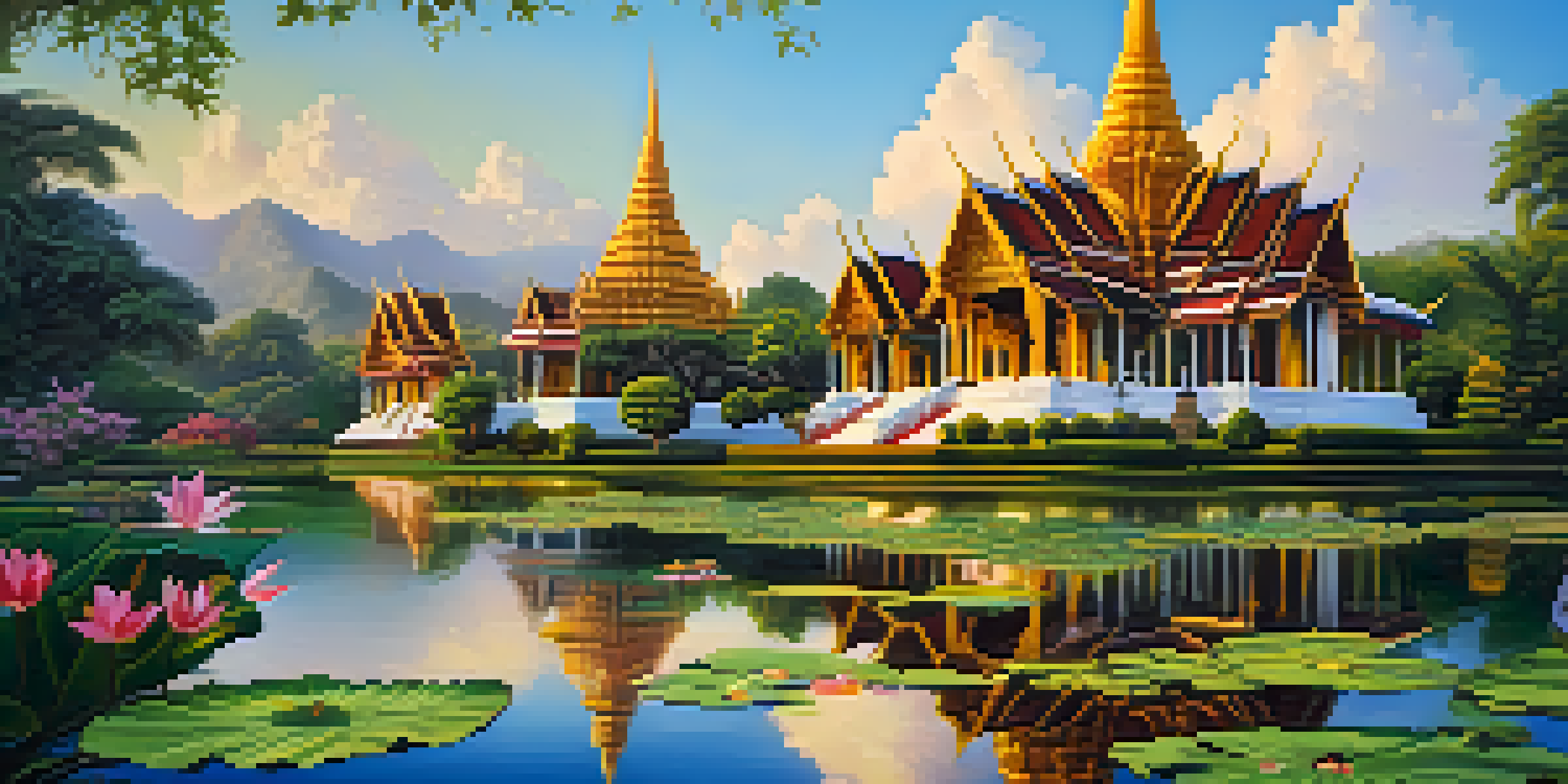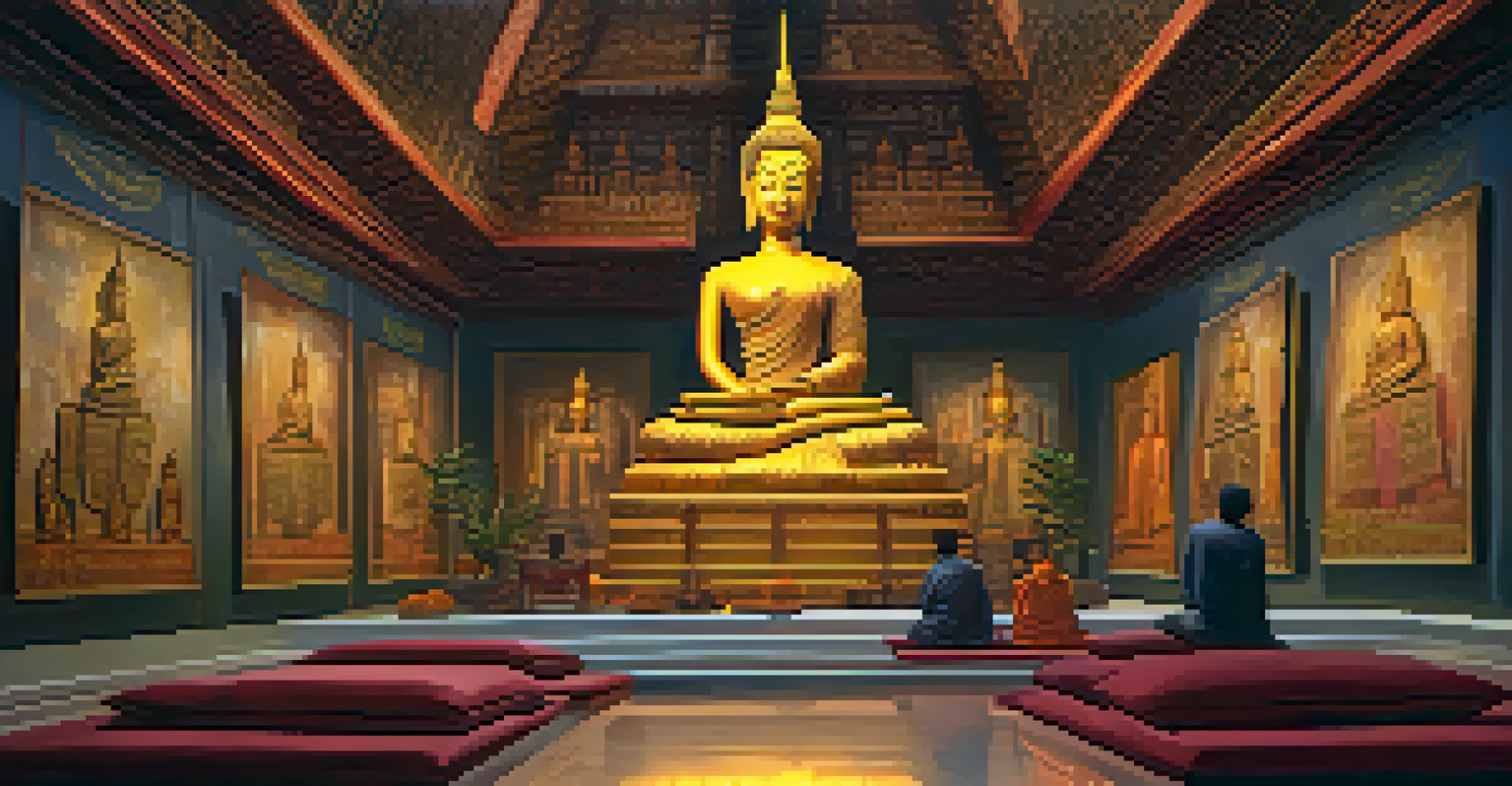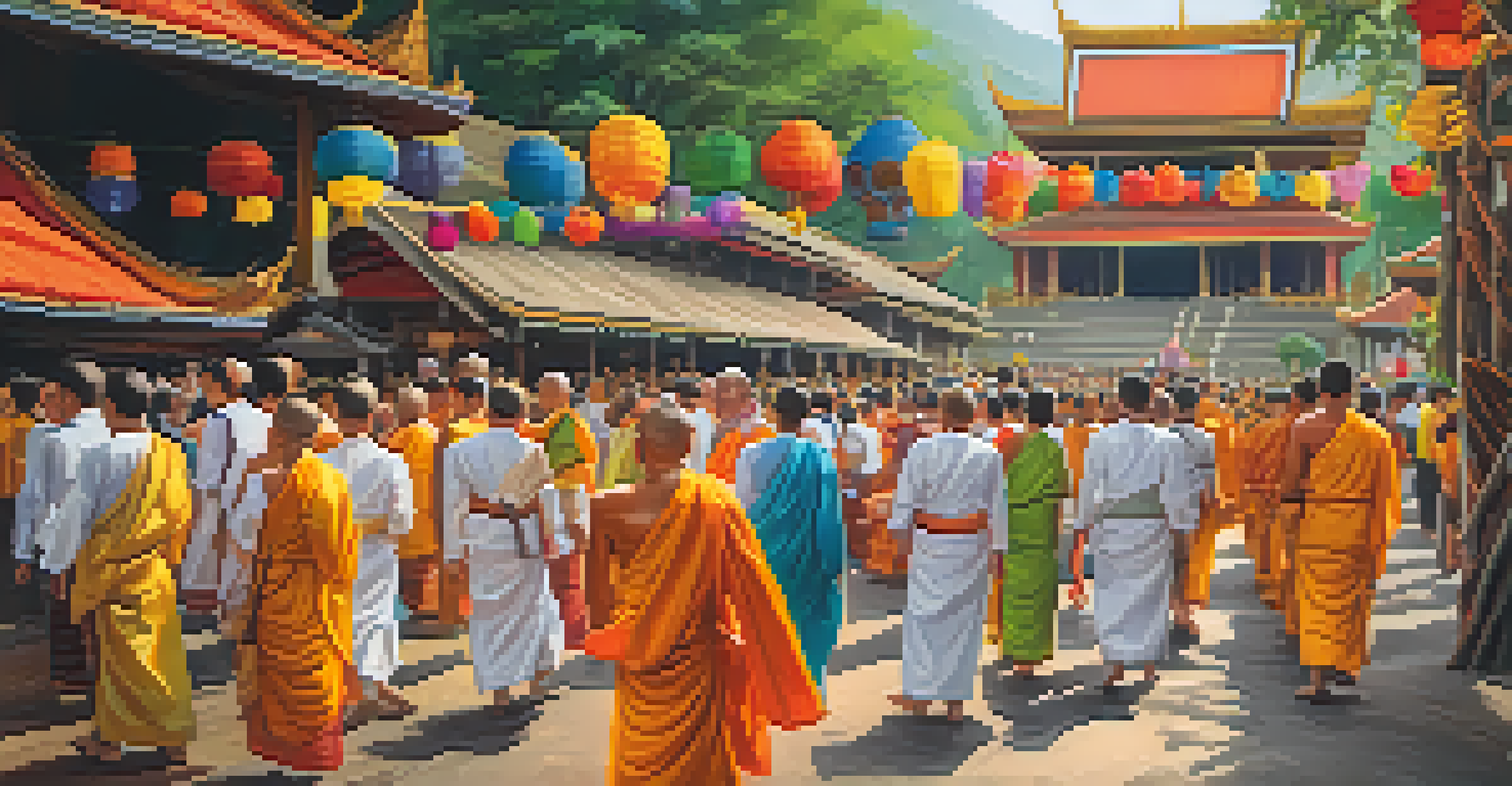The Architecture of Thai Temples: A Buddhist Perspective

The Significance of Thai Temples in Buddhism
Thai temples, or 'wats,' are more than just beautiful structures; they are sacred spaces that embody Buddhist teachings. Each temple serves as a hub for community worship and spiritual practice, fostering a deep connection between the people and their faith. The architecture reflects the values of Buddhism, promoting peace, mindfulness, and harmony.
Buddhism teaches that the mind is everything. What you think, you become.
In Buddhism, these temples are places for contemplation and meditation. They offer a serene environment where individuals can escape the chaos of daily life and focus on their spiritual journey. The atmosphere created by these architectural marvels encourages inner peace and self-reflection.
Moreover, Thai temples often act as centers for education, teaching not only religious practices but also cultural heritage. They are spaces where traditions are passed down through generations, allowing both locals and visitors to appreciate the rich history of Thai Buddhism.
Distinctive Features of Thai Temple Architecture
Thai temples showcase a unique architectural style characterized by their intricate designs and vibrant colors. Roofs are typically adorned with multiple tiers, often resembling a lotus flower, which is a significant symbol in Buddhism. This design is not only aesthetically pleasing but also represents spiritual enlightenment.

Another notable feature is the use of elaborate carvings and murals that depict stories from Buddhist scriptures. These artworks serve a dual purpose; they beautify the temple and educate visitors about the core values of Buddhism. The narratives told through these designs enrich the spiritual experience within the temple.
Cultural and Spiritual Hubs
Thai temples serve as vital centers for community worship, education, and the preservation of Buddhist traditions.
Additionally, the presence of stupas, or 'chedis,' is common in Thai temple complexes. These structures, which house relics or sacred objects, symbolize the path to enlightenment. Their towering presence commands respect and serves as a reminder of the sacredness of the space.
Symbolism in Thai Temple Design
Every element of Thai temple architecture is steeped in symbolism, reflecting the teachings of Buddhism. The orientation of temples often follows cardinal directions, aligning with the spiritual map of the universe. This layout is believed to enhance the flow of positive energy, or 'chi,' within the space.
Architecture is a visual art, and the buildings speak for themselves.
Colors also carry significant meanings; for instance, gold represents purity and enlightenment, while white symbolizes peace. These colors are carefully chosen to evoke specific emotions and create a harmonious atmosphere for worshippers. The overall aesthetic of a temple is designed to inspire reverence and tranquility.
Moreover, the use of statues and images of the Buddha throughout the temple complex serves as a visual representation of the teachings. They remind visitors of the qualities to aspire to, such as compassion and wisdom. This intentional design helps to reinforce the core tenets of Buddhism within the space.
Regional Variations in Thai Temple Architecture
While Thai temples share common features, regional variations reflect local cultures and traditions. For example, temples in the north often showcase intricate woodwork, while southern temples may emphasize colorful tiles and mosaics. These differences highlight the diversity within Thai Buddhism and its adaptation to various environments.
In the northeast, or Isan region, temple designs may incorporate elements from neighboring Laos, showcasing a blend of cultural influences. This fusion creates a unique architectural style that tells the story of the area's history and its spiritual journey. Each temple thus becomes a tapestry of cultural and religious narratives.
Symbolism in Architecture
Every aspect of Thai temple design is imbued with symbolic meaning, reflecting Buddhist teachings and enhancing spiritual experiences.
Visiting different regions of Thailand allows one to appreciate the rich diversity in temple architecture. Each temple provides a glimpse into the local customs and beliefs, making the exploration of these sacred spaces an enriching experience.
The Role of Monks in Temple Architecture
Monks play a crucial role in the construction and maintenance of Thai temples. They not only oversee the spiritual aspects of temple life but also engage in the design process, ensuring that the architecture aligns with Buddhist principles. Their involvement ensures that the temple remains a true reflection of the faith.
The process of building a temple is often a communal effort, with monks guiding local artisans and craftspeople. This collaboration fosters a sense of community and shared purpose, as everyone contributes to creating a sacred space. The temple thus becomes a symbol of collective devotion.
Additionally, monks are responsible for the ongoing rituals and ceremonies that take place within the temple. Their presence adds a spiritual dimension to the architecture, making it a living entity that evolves with the community's needs and experiences.
Preserving Thai Temple Architecture for Future Generations
As with many historical sites, preserving the integrity of Thai temple architecture is essential for future generations. Efforts are underway to restore and maintain these structures, ensuring they continue to serve as spiritual havens. Conservation projects often involve local communities, emphasizing the importance of collective stewardship.
Moreover, education about the architectural significance of these temples is vital. By teaching locals and tourists about their cultural heritage, we can foster a greater appreciation for the artistry and spirituality embedded in these structures. This awareness encourages respect and care for the temples.
Regional Diversity in Design
Variations in Thai temple architecture showcase local cultures and traditions, highlighting the rich diversity within Buddhism across different regions.
Incorporating modern technology into preservation efforts can also enhance maintenance practices. Techniques such as 3D scanning and restoration software allow for more accurate and efficient restoration, ensuring that these architectural treasures endure the test of time.
Experiencing the Beauty of Thai Temples
Visiting Thai temples offers a unique opportunity to immerse oneself in the rich cultural and spiritual heritage of Buddhism. As you walk through the ornate gates, the intricate designs and serene atmosphere invite introspection and reflection. Each temple visit can be a transformative experience, encouraging deeper connections with the teachings of Buddhism.
Interacting with monks and participating in local rituals can further enhance this experience. Many temples welcome visitors to engage in meditation sessions or traditional ceremonies, providing a glimpse into the daily lives of those who inhabit these sacred spaces. These interactions can foster a greater understanding of the values and practices that define Thai Buddhism.

Capturing the beauty of these temples through photography can also be a rewarding experience. The vibrant colors, intricate details, and serene landscapes create stunning visuals that tell the story of Thai culture. Sharing these experiences can inspire others to explore the rich tapestry of Thai temple architecture.